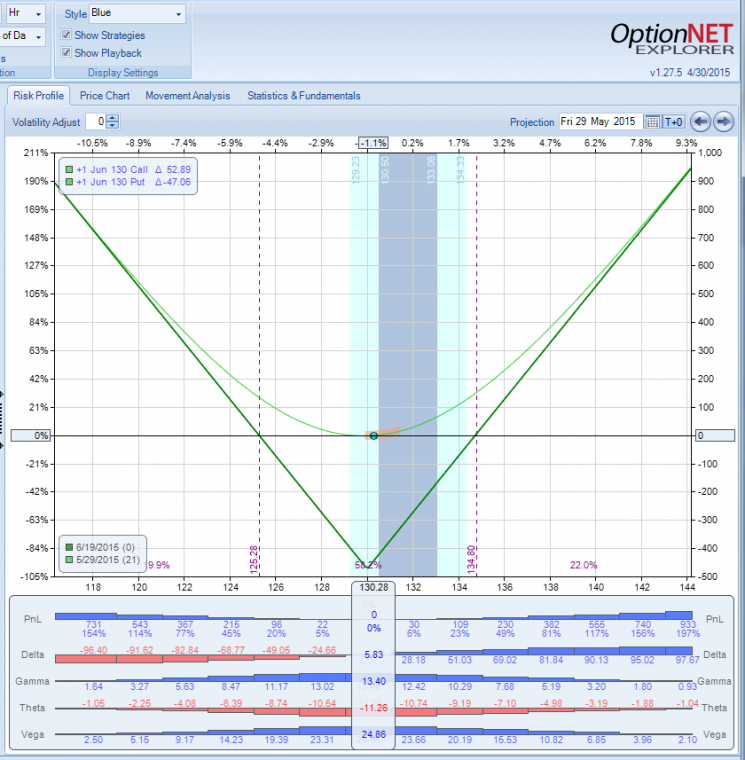
I'm often asked if 5% is a good return for an options trade. The answer is: it depends. One of the myths of options trading is that you should aim for at least 100% gain in each option trade, otherwise it is not worth the risk. Is it really the case?
Well, every trade should be put in context. Before evaluating a trade (or an options strategy), the following questions should be asked and answered:
- What is the holding period of the strategy?
- What is the maximum risk?
- What is the profit potential?
- What is the average return?
- What is the winning ratio?
Why holding period is important? Well, making 5% in one week is not the same as making 5% in six months. In the first case we are talking about 250% annualized return. In the second case, 10%. See the difference.
Maximum risk is important because it doesn't make sense to aim for 5% gain if your strategy can lose 50-100%. For example, when you are trading a directional strategy, and the stock gaps against you, the losses can be catastrophic. Since the risk is high, you should aim for higher return to compensate for the risk.
However, if your maximum risk is limited, you can aim for lower return and still get excellent overall performance.
Lets examine our pre-earnings straddles as an example.
As a reminder, a long straddle option strategy is vega positive, gamma positive and theta negative trade. It works based on the premise that both call and put options have unlimited profit potential but limited loss.
Straddles are a good strategy to pursue if you believe that a stock's price will move significantly, but unsure as to which direction. Another case is if you believe that Implied Volatility of the options will increase - for example, before a significant event like earnings. I explained the latter strategy in my Seeking Alpha article Exploiting Earnings Associated Rising Volatility . IV usually increases sharply a few days before earnings, and the increase should compensate for the negative theta. If the stock moves before earnings, the position can be sold for a profit or rolled to new strikes. This is one of my favorite strategies that we use in our SteadyOptions model portfolio.
This is how the P/L chart looks like:

How We Trade Straddle Option Strategy provides a full explanation of the strategy.
Lets take a look at 2017 statistics for this strategy:
- Number of trades: 77
- Number of winners: 62
- Number of losers: 15
- Winning ratio: 80.5%
- Average return per trade: 5.1%
- Average return per winning trade: 8.7%
- Average return per losing trade: -10.2%
- Average holding period: 7.2 days
Lets do a quick math. If you can do 10 trades per month, each trade producing 5% gain on average and 10% allocation per trade, your monthly return is 5% on the whole portfolio. That's 60% non compounded annual return, with minimal risk.
To answer the original question: for a strategy that has 80% winning ratio and loses on average 10% on losing trades, with average holding period of one week, 5% is an EXCELLENT return. In fact, I would consider it as Close to the Holy Grail as You Can Get.
What Is SteadyOptions?
Full Trading Plan
Complete Portfolio Approach
Diversified Options Strategies
Exclusive Community Forum
Steady And Consistent Gains
High Quality Education
Risk Management, Portfolio Size
Performance based on real fills
Non-directional Options Strategies
10-15 trade Ideas Per Month
Targets 5-7% Monthly Net Return
Recent Articles
Articles
Pricing Models and Volatility Problems
Most traders are aware of the volatility-related problem with the best-known option pricing model, Black-Scholes. The assumption under this model is that volatility remains constant over the entire remaining life of the option.
By Michael C. Thomsett, August 16

- Added byMichael C. Thomsett
- August 16
Option Arbitrage Risks
Options traders dealing in arbitrage might not appreciate the forms of risk they face. The typical arbitrage position is found in synthetic long or short stock. In these positions, the combined options act exactly like the underlying. This creates the arbitrage.
By Michael C. Thomsett, August 7

- Added byMichael C. Thomsett
- August 7
Why Haven't You Started Investing Yet?
You are probably aware that investment opportunities are great for building wealth. Whether you opt for stocks and shares, precious metals, forex trading, or something else besides, you could afford yourself financial freedom. But if you haven't dipped your toes into the world of investing yet, we have to ask ourselves why.
By Kim, August 7

- Added byKim
- August 7
Historical Drawdowns for Global Equity Portfolios
Globally diversified equity portfolios typically hold thousands of stocks across dozens of countries. This degree of diversification minimizes the risk of a single company, country, or sector. Because of this diversification, investors should be cautious about confusing temporary declines with permanent loss of capital like with single stocks.
By Jesse, August 6

- Added byJesse
- August 6
Types of Volatility
Are most options traders aware of five different types of volatility? Probably not. Most only deal with two types, historical and implied. All five types (historical, implied, future, forecast and seasonal), deserve some explanation and study.
By Michael C. Thomsett, August 1

- Added byMichael C. Thomsett
- August 1
The Performance Gap Between Large Growth and Small Value Stocks
Academic research suggests there are differences in expected returns among stocks over the long-term. Small companies with low fundamental valuations (Small Cap Value) have higher expected returns than big companies with high valuations (Large Cap Growth).
By Jesse, July 21

- Added byJesse
- July 21
How New Traders Can Use Trade Psychology To Succeed
People have been trying to figure out just what makes humans tick for hundreds of years. In some respects, we’ve come a long way, in others, we’ve barely scratched the surface. Like it or not, many industries take advantage of this knowledge to influence our behaviour and buying patterns.

- Added byKim
- July 21
A Reliable Reversal Signal
Options traders struggle constantly with the quest for reliable
By Michael C. Thomsett, July 20

- Added byMichael C. Thomsett
- July 20
Premium at Risk
Should options traders consider “premium at risk” when entering strategies? Most traders focus on calculated maximum profit or loss and breakeven price levels. But inefficiencies in option behavior, especially when close to expiration, make these basic calculations limited in value, and at times misleading.
By Michael C. Thomsett, July 13

- Added byMichael C. Thomsett
- July 13
Diversified Leveraged Anchor Performance
In our continued efforts to improve the Anchor strategy, in April of this year we began tracking a Diversified Leveraged Anchor strategy, under the theory that, over time, a diversified portfolio performs better than an undiversified portfolio in numerous metrics. Not only does overall performance tend to increase, but volatility and drawdowns tend to decrease: